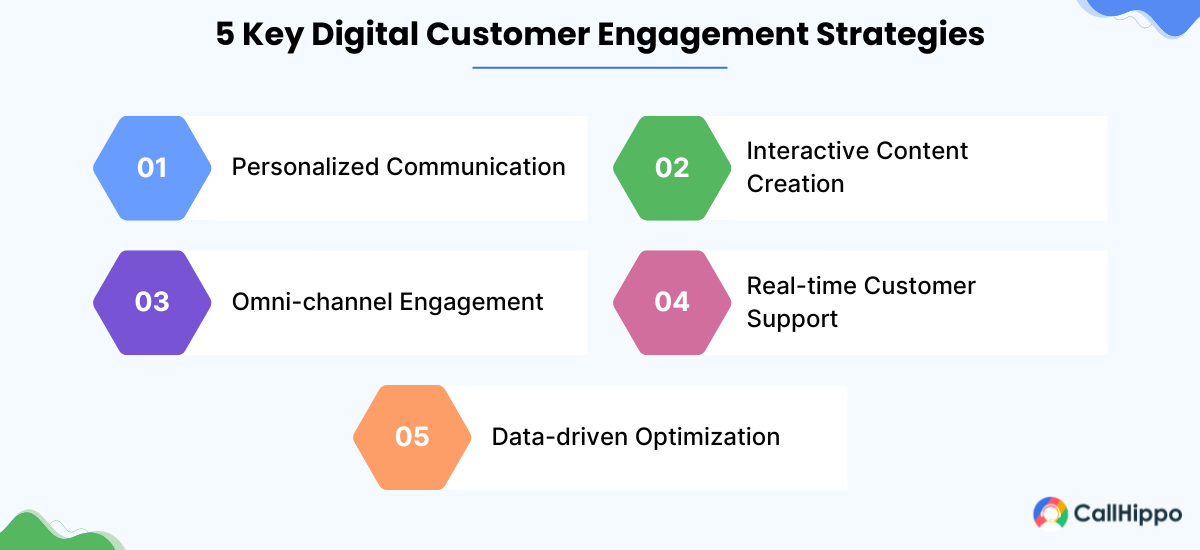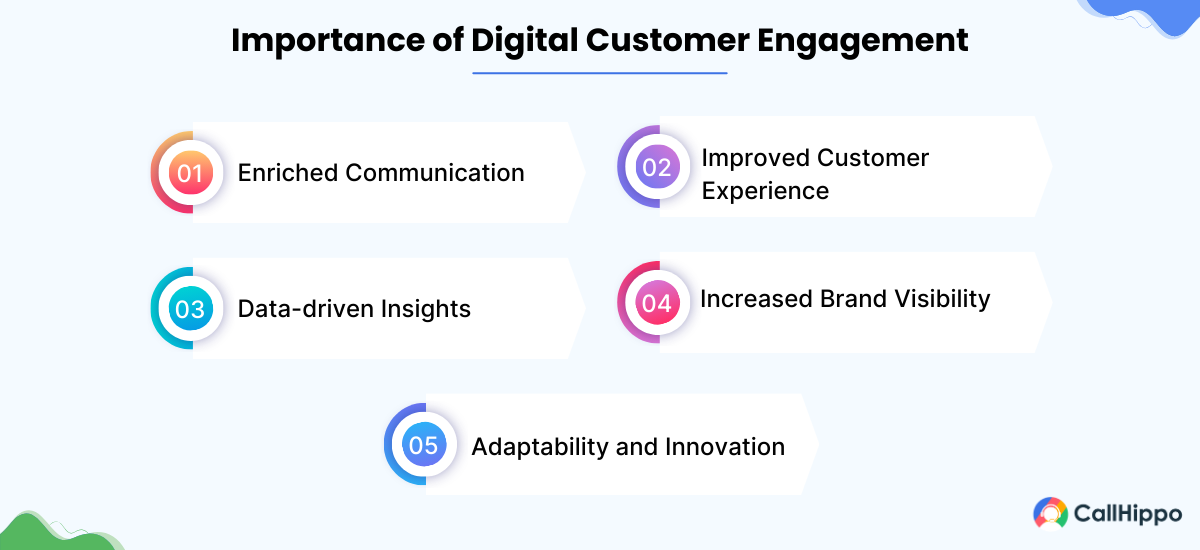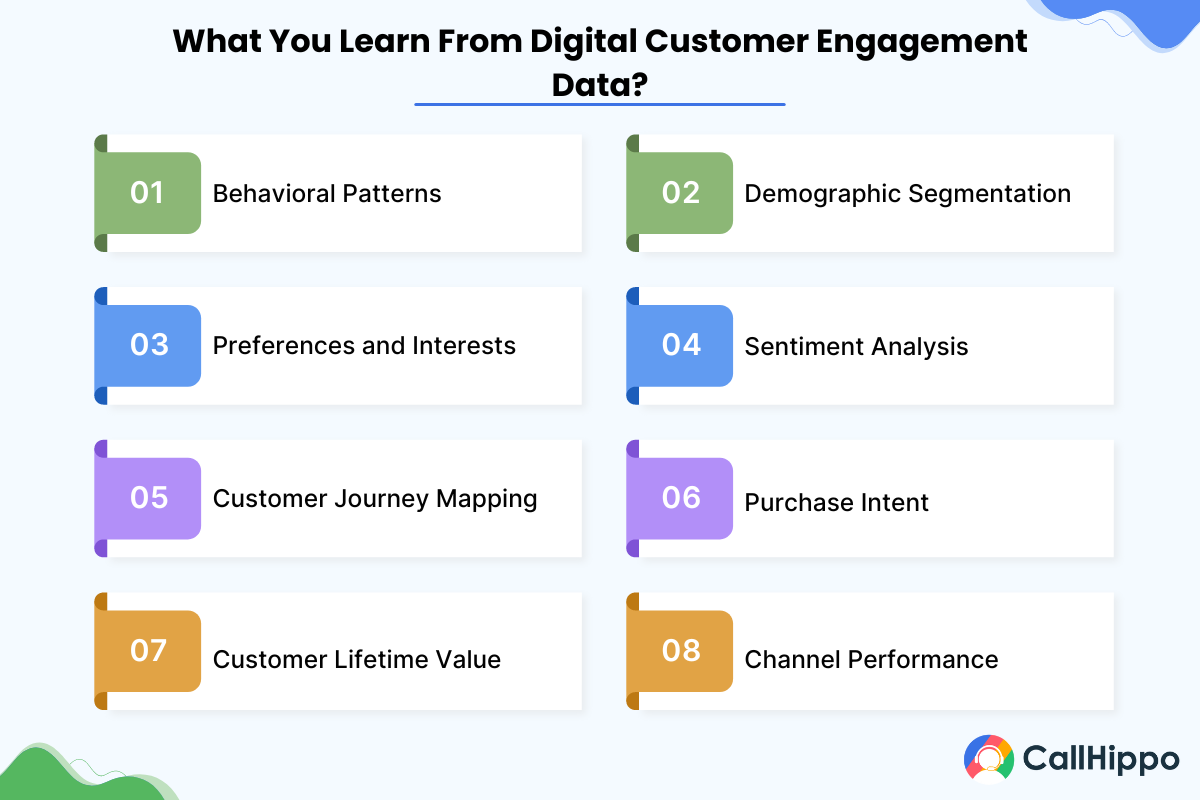To surpass your business & sales goals, you need higher conversion rates, and to attain that, you require effective customer engagement methods. However, over the years, customer engagement strategies have evolved significantly.
In this blog, we will explore all the key aspects of digital customer engagement strategies, including digital customer engagement models, along with several examples of digital customer engagement.
Let’s get started.
What is Digital Customer Engagement?
Digital customer engagement refers to how businesses interact with their customers using digital channels. This includes websites, social media, email, and mobile apps.
To reap the maximum results, you need a digital customer engagement strategy that helps you reach and retain customers online. Some of the key elements of a successful digital customer engagement strategy include:
- Personalization: Tailoring content and offers to individual preferences.
- Omni-channel communication: Ensuring consistent interaction across various digital platforms.
- Real-time support: Providing immediate assistance through chatbots or live chat.
It is worth noting that implementing an effective digital customer engagement solution can significantly improve the bottom line, including customer satisfaction and loyalty.
When implementing digital customer engagement strategies, focus on building authentic relationships with your audience. Use personalized communication, respond promptly to inquiries, and seek feedback to continuously improve.
Customer Engagement vs. Digital Customer Engagement
As the name implies, both customer engagement and digital customer engagement revolve around how businesses interact with their customers to build strong relationships. However, there are some significant differences in terms of the channels they use, costs, analytics, and more.
| Aspect | Traditional Customer Engagement | Digital Customer Engagement |
|---|---|---|
| Channels of Interaction | In-person interactions, phone conversations, physical mail | Websites, social media, email, mobile apps |
| Reach and Accessibility | Limited to physical locations and direct interactions | Global reach through digital channels, accessible 24/7 |
| Data and Analytics | Manual data collection through surveys and feedback forms | Automated data collection with real-time insights using advanced analytics tools |
| Personalization and Automation | Manual personalization, less precise | Automated and personalized interactions using customer data |
| Customer Feedback and Adaptability | Slow feedback collection and adaptation takes time | Instant feedback through online reviews and comments, quick adaptability |
| Cost and Resource Efficiency | High investment in physical infrastructure and staff | Cost-effective with digital tools and platforms, efficient use of resources |
Here are 6 key differences between traditional customer engagement and digital customer engagement:
https://webcdn.callhippo.com/blog/wp-content/uploads/2024/06/difference-between-customer-engagement-and-digital-customer-engagement.png
1. Channels of Interaction
The first notable difference between traditional customer engagement and digital customer engagement is the channel of interaction.
Customer Engagement: Traditional customer engagement relies heavily on physical and direct communication channels. This includes in-person interactions at stores, phone conversations, and physical mail. It’s personal and often involves direct human contact.
Digital Customer Engagement: In contrast, digital customer engagement happens using digital communication tools like websites, social media, email, and mobile apps. This approach utilizes a digital customer engagement strategy to connect with customers where they spend most of their time—online. By identifying social media accounts linked to phone number, companies can gain valuable customer online presence and tailor communications accordingly.
2. Reach and Accessibility
The next difference between traditional customer engagement and digital customer engagement is reach and accessibility.
Customer Engagement: The reach of traditional customer engagement is limited to physical locations and direct interactions. It often requires the customer to be present or available at a specific place and time.
Digital Customer Engagement: A digital customer engagement model allows businesses to scale their efforts effortlessly. Digital channels can reach millions of customers worldwide instantly. This scalability enables businesses to grow their customer base without the limitations of physical boundaries.
3. Data and Analytics
Another key difference between traditional customer engagement and digital customer engagement is the use of data and analytics
Customer Engagement: Gathering customer data in traditional engagement often involves manual processes like surveys and feedback forms. This method can be time-consuming and may not provide real-time insights.
Digital Customer Engagement: On the other hand, digital customer engagement solutions offer advanced analytics tools that collect and analyze customer data automatically. These tools provide real-time insights into customer behavior, preferences, and interactions. Businesses can use this data to personalize their digital engagement strategy.
4. Personalization and Automation
In addition to these, a significant difference between traditional customer engagement and digital customer engagement is personalization and automation.
Customer Engagement: Personalization in traditional engagement is often done manually and may not be as precise. It requires a lot of effort to remember customer preferences and tailor interactions accordingly.
Digital Customer Engagement: In contrast, digital customer engagement models use technology to automate and personalize interactions. For instance, customer data can be used to send personalized emails, recommend products, or provide targeted advertisements.
5. Customer Feedback and Adaptability
Moreover, customer feedback and adaptability mark another major difference between traditional customer engagement and digital customer engagement.
Customer Engagement: Gathering feedback in traditional customer engagement is slower and may involve methods like suggestion boxes or in-person surveys. Adapting to this feedback can also take time.
Digital Customer Engagement: Digital platforms enable instant feedback through online reviews, social media comments, and surveys. Businesses can quickly respond to customer concerns and adapt their strategies. This agility helps in maintaining a positive brand image and fostering customer loyalty.
6. Cost and Resource Efficiency
Last but not least, cost and resource efficiency is also a crucial difference between traditional customer engagement and digital customer engagement.
Traditional Customer Engagement: Traditional methods often require significant investment in physical infrastructure, staff, and materials. These costs can be substantial, especially for small businesses.
Digital Customer Engagement: Implementing a digital customer engagement strategy is generally more cost-effective. Digital tools and platforms can automate many processes, reducing the need for extensive physical resources. Additionally, digital campaigns can be more easily measured and fine-tuned, ensuring efficient use of resources.
All in all, while traditional customer engagement focuses on in-person and direct methods, digital customer engagement leverages technology to interact with customers through various online channels.
Digital Customer Engagement Strategies
To effectively engage customers in the digital realm, businesses can implement various strategies tailored to their specific needs. Here are five effective digital customer engagement strategies:

1. Personalized Communication
One of the most impactful digital engagement strategies is personalized communication. By collecting and analyzing customer data, businesses can tailor their messages and interactions to individual preferences and behaviors.
This can include personalized email marketing campaigns, targeted social media advertisements, and customized product recommendations on websites. Personalization makes customers feel valued and understood, increasing their likelihood of engaging with the brand and making purchases.
2. Interactive Content Creation
Creating interactive content is another powerful way to engage customers digitally. Interactive content, such as quizzes, polls, surveys, and contests, encourages active participation from users. This will eventually make the experience more engaging and memorable.
By adding interactive elements into their digital platforms, businesses can capture the attention of their target audience and develop meaningful interactions. Additionally, interactive content provides valuable insights into customer preferences, which can inform future marketing strategies.
3. Omni-channel Engagement
Omni-channel engagement involves providing a seamless experience across multiple digital channels, such as websites, social media, mobile apps, and messaging platforms.
By integrating these channels and ensuring consistency in branding, businesses can create a unified customer experience regardless of the platform used. This allows customers to interact with the brand on their preferred channels and provides them with greater flexibility.
Omni-channel engagement also enables businesses to reach customers at different touchpoints along their journey, improving overall customer satisfaction.
4. Real-time Customer Support
Offering real-time customer support is essential for effective digital customer engagement. With the rise of instant messaging and chatbot technologies, businesses can provide immediate assistance to customers whenever they have questions or concerns.
Implementing live chat support on websites and mobile apps allows customers to receive instant responses to their inquiries, improving their overall experience.
Additionally, AI-powered chatbots can handle routine customer service tasks, freeing up human agents to focus on more complex issues.
5. Data-driven Optimization
Data-driven optimization involves using analytics and insights to continuously improve digital customer engagement efforts.
By monitoring key metrics such as website traffic, conversion rates, and customer feedback, businesses can identify areas for improvement and refine their strategies accordingly. This may involve A/B testing different marketing campaigns, optimizing website design, or adjusting messaging based on customer preferences.
By utilizing data to make informed decisions, businesses can maximize the effectiveness of their digital customer engagement strategies and drive better results.
Digital Customer Engagement Examples
Let’s now explore three digital customer engagement examples to better understand how digital customer engagement strategies can help your business.
Example 1: Social Media Listening and Response
Suppose you are a retail company selling fashion accessories. You have a strong presence on social media platforms like Instagram and Facebook.
What is Social Media Listening?
Social media listening involves monitoring online conversations on social platforms to understand what people are saying about a brand, product, or topic.
Your digital engagement strategy involves actively monitoring conversations related to your brand and industry.
One day, a customer posts a photo wearing your latest product but mentions facing an issue with its functionality. Here’s where your digital customer engagement strategy comes into the picture. Your team quickly identifies the post through social media listening tools and responds promptly, acknowledging the customer’s concern and offering a solution.
Not only does this demonstrate your commitment to customer satisfaction, but it also showcases responsiveness. Such actions will help you develop trust and loyalty among your audience.
Example 2: Personalized Email Marketing Campaigns
Let’s take another scenario. Suppose you are operating an e-commerce company specializing in personalized gifts. As part of your digital customer engagement solution, you leverage data analytics to segment your customer base and tailor your email marketing campaigns accordingly.
For instance, a customer who recently purchased a custom-made necklace for their partner’s birthday receives an email suggesting complementary products or offering a discount on their next purchase.
Boost Digital Customer Engagement With CallHippo
Engage, convert, and delight customers with CallHippo's reliable, feature-packed communication platform. Start your free trial today.
By delivering personalized content based on past interactions and preferences, you not only boost the relevance of your communications but also ensure higher engagement rates and increased sales conversions.
Example 3: Interactive Customer Support Portals
Let’s now move from an ecommerce company to a software-as-a-service (SaaS) company that provides project management solutions to businesses.
Recognizing the importance of digital customer engagement, they developed an interactive support portal where users can access a knowledge base, submit inquiries, and engage in live chat support.
When a customer encounters a technical issue while using the platform, they can easily find troubleshooting guides or initiate a chat session with a support agent directly within the portal.
This digital engagement model not only simplifies the customer support process but also empowers users to resolve issues independently. This will eventually reduce frustration and improve overall satisfaction.
As we can see, these three examples of digital customer engagement strategies illustrate the diverse ways in which digital customer engagement strategies can drive value for businesses across various industries.
Why is Digital Customer Engagement Important?
Based on the information provided above, it must be clear to you why connecting with customers through digital channels has become more important than ever before.
Let’s explore five key factors that establish the importance of digital customer engagement.

A. Enriched Communication
Digital customer engagement is all about talking to your customers in the online world. It means using platforms like social media, email, or chatbots to have conversations with them.
When businesses respond quickly to questions or problems online, it shows customers that they care. This helps build better relationships between businesses and customers.
For example, when a customer sends a message on social media asking about a product, and the business replies right away, it makes the customer feel heard and valued. This kind of quick and personal communication can make a big difference in customer loyalty.
B. Improved Customer Experience
Digital engagement isn’t just about talking; it’s also about making sure customers have a great experience when they interact with a business online.
This means personalizing recommendations based on what a customer has bought before or making it easy for them to find what they are looking for on a website. When businesses make the online experience smooth and tailored to each customer, it makes them more likely to come back in the future.
For instance, when a website remembers a customer’s preferences and suggests products they might like, it creates a positive experience that keeps the customer coming back for more.
C. Data-driven Insights
One of the great things about digital customer engagement is that it allows businesses to gather lots of information about their customers. This could be things like what products they buy, how often they visit a website, or what they say on social media.

By looking at this data, businesses can learn a lot about their customers’ likes, dislikes, and behaviors. Eventually, it helps them make better decisions about things like what products to sell, how to market them, or how to improve their customer service.
For an instance, if a business sees that lots of customers are asking the same question on social media, they can use that information to create a helpful FAQ section on their website.
D. Increased Brand Visibility
Digital customer engagement is also a great way for businesses to get their brand out there and be seen by customers.
By being active on social media, sending out regular emails, or running online ads, businesses can make sure they are staying on customers’ minds. When businesses engage with customers online, it helps keep their brand top-of-mind.
For example, when a business shares interesting content on social media or runs a fun giveaway, it gets people talking about the brand and sharing it with their friends. This kind of word-of-mouth marketing can be really powerful for growing a business.
E. Adaptability and Innovation
Digital customer engagement isn’t just about doing things the same way all the time; it’s about being flexible and trying new things. This might mean experimenting with new social media platforms.
For example, when a business sees a new trend emerging on social media and jumps on it quickly, it can help them stand out and attract new customers. This kind of innovation is key to staying relevant in today’s competitive business world.
As we can see, digital customer engagement isn’t just a nice-to-have for businesses; it’s essential for success in today’s internet-driven era. This also means you must invest in the right digital customer engagement solutions that help you achieve your goals.
Conclusion
Without a doubt, implementing effective digital customer engagement strategies is paramount for modern businesses. By prioritizing clear communication, personalized experiences, and leveraging data-driven insights, companies can build stronger connections with their customers. Nevertheless, for maximum results, it’s essential to use the best digital customer engagement solutions and to stay agile and adaptable to the evolving digital trends.
FAQs
1. What is digital-first customer engagement?
Digital-first customer engagement prioritizes online interactions over traditional methods, focusing on channels like social media, email, and websites to connect with customers efficiently and effectively.
2. What is virtual customer engagement?
Virtual customer engagement involves interacting with customers through digital platforms like video calls, online chat, or virtual events, providing personalized experiences without physical presence.
3. What is a digital engagement tool?
A digital engagement tool is a software or application designed to facilitate interactions between businesses and customers online, such as chatbots, email marketing platforms, or social media management tools.
4. What is digital engagement practice?
Digital engagement practice refers to the strategies and methods used by businesses to interact with customers online, including social media engagement, email marketing campaigns, and website optimization for user experience.

Subscribe to our newsletter & never miss our latest news and promotions.









